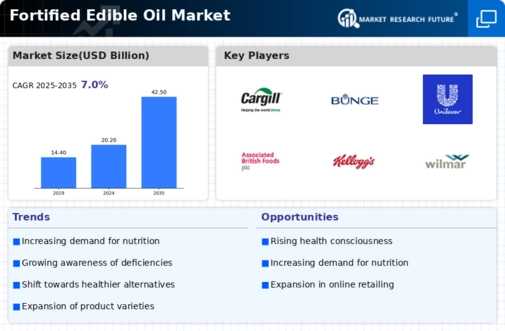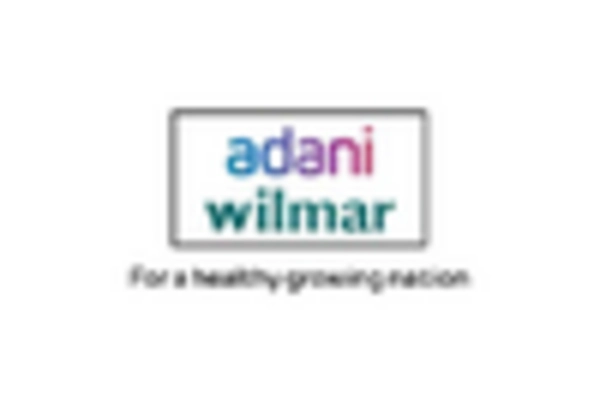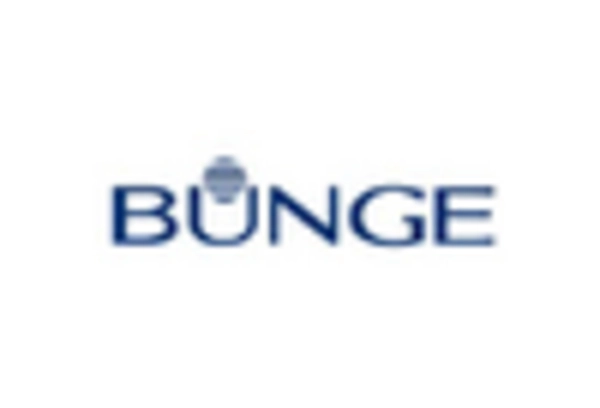Innovative Product Development
The Fortified Edible Oil Market is characterized by continuous innovation in product development. Manufacturers are increasingly focusing on creating diverse offerings that cater to the evolving preferences of health-conscious consumers. This includes the introduction of oils fortified with omega-3 fatty acids, plant sterols, and other beneficial ingredients. Such innovations not only enhance the nutritional value of the oils but also provide consumers with a wider range of choices. Recent market analysis suggests that the introduction of new fortified products could lead to a 7% increase in market share for companies that prioritize research and development. This emphasis on innovation is likely to play a crucial role in shaping the future landscape of the fortified edible oil market.
Increasing Nutritional Awareness
The Fortified Edible Oil Market is experiencing a surge in demand due to rising nutritional awareness among consumers. As individuals become more informed about the health benefits of fortified oils, they are increasingly opting for products that offer enhanced nutritional profiles. This trend is particularly evident in regions where malnutrition remains a concern, prompting consumers to seek oils enriched with vitamins and minerals. According to recent data, the market for fortified edible oils is projected to grow at a compound annual growth rate of approximately 5.5% over the next five years. This growth is indicative of a broader shift towards healthier dietary choices, as consumers prioritize products that contribute positively to their overall well-being.
Government Initiatives and Regulations
The Fortified Edible Oil Market is significantly influenced by government initiatives aimed at improving public health. Various governments have implemented regulations that mandate the fortification of edible oils with essential nutrients, particularly in regions with high rates of micronutrient deficiencies. These regulations not only enhance the nutritional quality of oils but also encourage manufacturers to innovate and expand their product lines. For instance, in several countries, the fortification of cooking oils with vitamins A and D has become a standard practice, thereby increasing the availability of fortified products in the market. This regulatory support is expected to drive the growth of the fortified edible oil sector, as compliance with these standards becomes essential for market participation.
Rising Demand for Healthy Cooking Options
The Fortified Edible Oil Market is witnessing a notable increase in demand for healthier cooking options. As consumers become more health-conscious, they are actively seeking oils that not only provide essential nutrients but also promote overall health. This shift is reflected in the growing popularity of oils that are low in saturated fats and high in unsaturated fats, such as olive and canola oils. Market data indicates that the demand for fortified oils is expected to rise, with a projected increase of 6% in the next few years. This trend is further fueled by the increasing prevalence of lifestyle-related diseases, prompting consumers to make informed choices about their cooking oils.
Growing Urbanization and Changing Lifestyles
The Fortified Edible Oil Market is being shaped by the trends of urbanization and changing lifestyles. As urban populations expand, there is a corresponding shift in dietary habits, with consumers increasingly favoring convenience and ready-to-use products. This urban lifestyle often leads to a higher consumption of processed foods, which can lack essential nutrients. Consequently, fortified edible oils are becoming a preferred choice for many households, as they offer a simple solution to enhance nutritional intake. Market projections indicate that urbanization could contribute to a 4% increase in the demand for fortified oils over the next few years. This trend underscores the importance of adapting to the evolving needs of urban consumers in the fortified edible oil sector.


















Leave a Comment